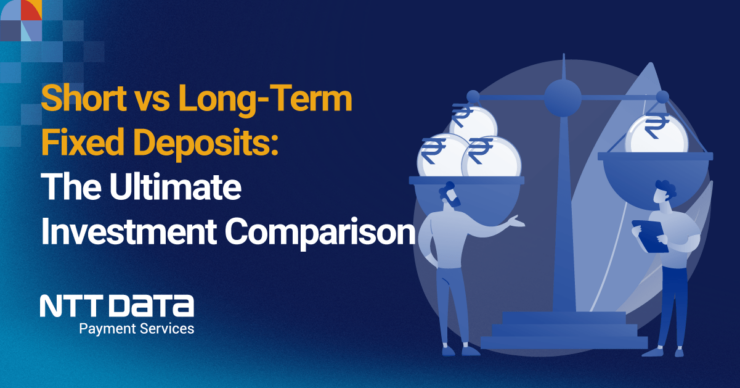
Table of Contents [show]
When it comes to investing, fixed deposits are a popular option for many people. Fixed deposits offer a reliable and secure way to earn interest on your savings, making them a great option for those looking for a low-risk investment.
However, not all fixed deposits are created equal.
There are two main types of fixed deposits: short-term and long-term. Each has its advantages and disadvantages, and it can be tough to decide which one is best for your investment goals.
In this blog post, we’ll take a closer look at short-term and long-term fixed deposits and compare the two, so you can make an informed decision and choose the right investment for you.
Short-Term Fixed Deposits

What are they?
Short-term fixed deposits are investment accounts that require a minimum investment period of 7 days and a maximum of 2 years. This type of investment allows individuals to deposit a specific amount of money for a brief duration, allowing it to accumulate interest over that time.
These deposits offer lower interest rates than long-term fixed deposits but they provide greater flexibility and liquidity, allowing investors to access their funds when needed.
Advantages of Short-Term Fixed Deposits
Short-term fixed deposits offer several benefits, including:
1. Flexibility
Short-term fixed deposits allow investors to deposit their money for a short period of time, typically ranging from a few days to a few months. This provides greater flexibility, as investors can access their funds when needed.
2. Liquidity
Due to the high liquidity of short-term fixed deposits, investors can withdraw their money without incurring any fees or losing interest.
3. Lower Risk
Given that the interest rate is fixed and the principal amount is insured by the financial institution, short-term fixed deposits are a low-risk investment option.
4. Safe Option
Short-term fixed deposits are considered one of the safest investment options, as market fluctuations do not impact them.
5. Achieve Small-Term Goals
Short-term fixed deposits are a great way to begin saving small amounts of money and achieving short-term financial goals, such as purchasing a gift for a loved one.
Disadvantages of Short-Term Fixed Deposits
Here are some of the potential disadvantages of short-term fixed deposits:
1. Reinvestment Risk
When a short-term fixed deposit matures, investors may be forced to reinvest the funds at a lower interest rate if interest rates have fallen, potentially resulting in a loss of income.
2. Inflation Risk
Short-term fixed deposit interest rates may not keep pace with inflation, resulting in lower real returns.
3. Lower Interest Rates
Short-term fixed deposits typically have lower interest rates than long-term fixed deposits, which means that the returns may also be lower.
4. Tax Returns
According to the Income Tax Law, any interest received on the invested sum is subject to taxation. The interest earned would be deducted as 10% TDS if it exceeds Rs 10,000. This limit is Rs 50,000 for senior citizens. That’s why fixed deposits are a wise choice for senior citizens!
Long-Term Fixed Deposits
Long-term fixed deposits are a type of investment where a fixed amount of money is deposited with a financial institution for an extended period of time, typically ranging from 5 years to 10 years. Similar to normal FDs, long-term FDs offer greater liquidity and more profitable returns.
These deposits are suitable for those seeking stable, long-term returns.
Advantages of Long-Term Fixed Deposits
Long-term fixed deposits have several advantages, including:
1. Higher interest rates
Long-term fixed deposits are a more attractive choice for people seeking bigger returns due to their customarily high interest rates of 6% to 7%.
2. Guaranteed returns
Long-term fixed deposits have an interest rate that is fixed for the duration of the deposit and are less subject to market fluctuations. This ensures a steady ROI.
3. Loan facilities
Banks and financial institutions frequently provide loans in exchange for long-term fixed deposits, allowing investors to access funds when needed without breaking the deposit.
4. Auto-renewal
Additionally, long-term FDs have the option of auto-renewal, in which case the FD account is automatically renewed without undergoing any additional procedures.
5. Tax benefits
Long-term fixed deposits often come with tax benefits, such as deductions under Section 80C of the Income Tax Act, which can help to reduce the overall tax liability.
Disadvantages of Long-Term Fixed Deposits
While long-term fixed deposits can be a reliable and safe investment option for many, there are some potential disadvantages to consider, including:
1. Rigid lock-in period
The minimum lock-in period for long-term deposits is roughly five years. The value of money may decline over time as a result of this. Additionally, the interest rates offered on these FDs might not be sufficient to reduce the risk of inflation.
2. Lower flexibility
Long-term fixed deposits typically do not allow for early withdrawal or partial withdrawals. You might be required to pay a penalty as a result of making a premature withdrawal, depending on the terms and conditions of your bank and the type of fixed deposit you have.
3. Interest rate risk
The returns from long-term fixed deposits may become less appealing compared to other investment options if interest rates increase during the investment period.
4. Lack of options
Although there are numerous fixed interest possibilities, there aren’t many evident long-term funds or deposits that investors can still make an investment in.
Short vs Long-term Fixed Deposits: Which one is better?
When it comes to choosing between short-term and long-term fixed deposits, it’s important to consider your investment goals, financial situation, and time horizon.
Short-term fixed deposits give investors more flexibility and liquidity so they can access their money whenever they need to. They are ideal for investors with a shorter time horizon who are seeking a low-risk investment alternative.
However, the interest rates offered on short-term fixed deposits are generally lower than on long-term deposits.
Long-term fixed deposits, on the other hand, offer higher interest rates and more stability, making them a more appealing choice for people who want to invest for a longer period of time.
However, they come with the risk of lower liquidity and flexibility, and investors may miss out on potential investment opportunities that arise in the short to medium term.
The decision between investing in short-term and long-term fixed deposits ultimately comes down to personal investment objectives and time horizons.
It’s always a good idea to consult with a financial advisor to determine which type of fixed deposit is best suited for your investment needs. Additionally, investors may also consider a mix of short-term and long-term fixed deposits to balance liquidity and returns.
Why choose NTT DATA Payment Services?
- High success rates of payments
- Instant settlements
- Multiple payment options
- Easy EMI solution
- 24/7 support
- Fraud prevention and advanced encryption system
NTT DATA Payment Services offers a complete payment solution to advance both your offline and online businesses from,
We ensure maximum comfort, convenience, and safety for all your payments.
Today for all your digital payment needs!
Conclusion
When it comes to choosing between short-term and long-term fixed deposits, there is no one-size-fits-all answer. Each type of fixed deposit has its own set of advantages and disadvantages, and the best choice depends on individual investment goals and time horizons.
Short-term fixed deposits offer greater flexibility and liquidity, while long-term fixed deposits provide higher interest rates and greater stability.
Ultimately, investors should carefully consider their investment goals, assess their financial situation, and weigh the pros and cons of each option before making a decision.
Short-Term vs Long-Term Fixed Deposits FAQs
1. What is the difference between short-term and long-term deposits?
Short-term deposits have a shorter investment horizon, while long-term deposits require a longer investment period of a minimum of one year.
2. Is short-term FD good?
Short-term investment is quite safe, and market fluctuations have little bearing on it. The short-term FD has liquidity, allowing the depositor to withdraw funds before maturity.
3. Which FD tenure is best?
Banks often provide their best interest rates on FDs with terms of 2-5 years. Therefore, you can expect a larger return if your tenure falls within this range.
4. Can I break my FD anytime?
Yes, you can break your FD anytime you want. But if you are making a premature withdrawal, you will be charged a penalty for it.
5. Is FD better than stocks?
Fixed deposits have a set period and investors can withdraw the funds early. Stocks can be sold anytime but may involve a loss of principal. Saving with fixed deposits is a safer option as it offers guaranteed returns.


